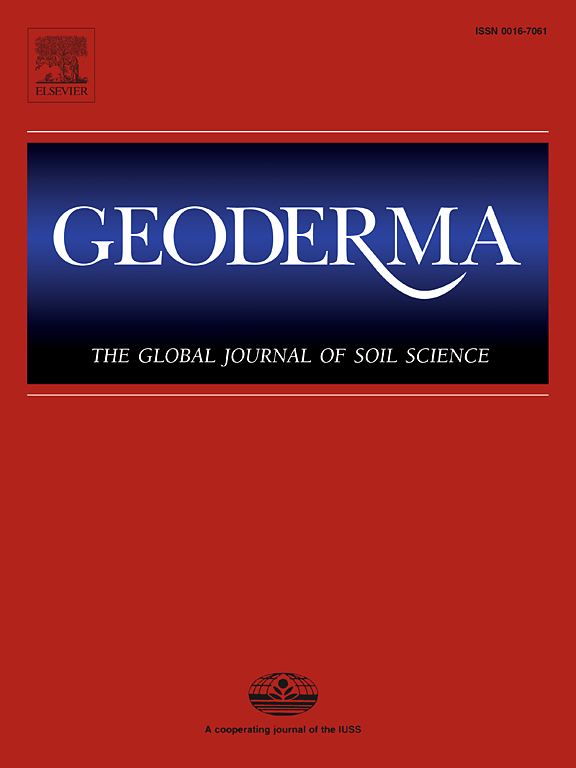基于土壤和叶片高光谱反射率分数阶导数积分的红树林土壤有机碳估算方法
IF 5.6
1区 农林科学
Q1 SOIL SCIENCE
引用次数: 0
摘要
红树林生态系统对固碳和海岸保护至关重要,但由于动态植被覆盖引起的光谱干扰,利用遥感准确估算土壤有机碳(SOC)仍然具有挑战性。本研究提出了一个将分数阶导数(FOD)技术与机器学习算法相结合的框架,用于红树林湿地有机碳估算。在中国南方5个红树林湿地共采集201份土壤样本。FOD应用于土壤和叶片的高光谱反射率,以放大通常被传统方法忽略的细微光谱变化。使用Shapley加性解释-极端梯度增强(Shapley Additive explations&extreme Gradient Boosting)方法确定soc敏感波长。使用Random Forest、XGBoost和CatBoost (Categorical Boosting)算法,共构建了363个建模策略,涵盖11个植被覆盖水平(0 - 100%)和11个分数阶(0-2,0.2间隔)。结果表明0.8和1.4之间的分数顺序始终产生优越的性能。CatBoost模型在10%植被覆盖和分数阶为1.2时获得了最高的精度(R2 = 0.730, RMSE = 0.858%)。将关键土壤和地形变量(如土壤铁、粘土含量、pH、盐度、氧化还原电位和海拔)纳入基于光谱的有机碳估算模型,显著提高了预测精度,突出了光谱信号、土壤特征和地形特征在有机碳建模中的互补作用。该框架具有推进蓝碳核算和支持在不断变化的环境条件下可持续红树林保护和管理的潜力。本文章由计算机程序翻译,如有差异,请以英文原文为准。
Integrating fractional-order derivatives of soil and leaf hyperspectral reflectance for improved estimation of mangrove soil organic carbon
Mangrove ecosystems are vital for carbon sequestration and coastal protection, yet accurate estimation of soil organic carbon (SOC) using remote sensing remains challenging due to spectral interference caused by dynamic vegetation cover. This study presents a novel framework integrating fractional-order derivative (FOD) techniques with machine learning algorithms for SOC estimation in mangrove wetlands. A total of 201 soil samples were collected from five mangrove wetlands in southern China. FOD was applied to both soil and leaf hyperspectral reflectance to amplify subtle spectral variations typically overlooked by conventional approaches. SOC-sensitive wavelengths were identified using the SHAP-XGBoost (Shapley Additive Explanations-Extreme Gradient Boosting) method. A total of 363 modeling strategies were constructed using Random Forest, XGBoost, and CatBoost (Categorical Boosting) algorithms across 11 vegetation cover levels (0–100 %) and 11 fractional orders (0–2 at 0.2 intervals). Results indicate that fractional orders between 0.8 and 1.4 consistently yielded superior performance. The CatBoost model under 10 % vegetation cover and a fractional order of 1.2 achieved the highest accuracy (R2 = 0.730, RMSE = 0.858 %). Incorporating key soil and terrain variables (e.g. soil iron, clay content, pH, salinity, redox potential, and elevation) into the spectra-based SOC estimation model significantly enhanced prediction accuracy, highlighting the complementary roles of spectral signals, soil characteristics, and topographic features in SOC modeling. This framework holds the potential for advancing blue carbon accounting and supporting sustainable mangrove conservation and management under changing environmental conditions.
求助全文
通过发布文献求助,成功后即可免费获取论文全文。
去求助
来源期刊

Geoderma
农林科学-土壤科学
CiteScore
11.80
自引率
6.60%
发文量
597
审稿时长
58 days
期刊介绍:
Geoderma - the global journal of soil science - welcomes authors, readers and soil research from all parts of the world, encourages worldwide soil studies, and embraces all aspects of soil science and its associated pedagogy. The journal particularly welcomes interdisciplinary work focusing on dynamic soil processes and functions across space and time.
 求助内容:
求助内容: 应助结果提醒方式:
应助结果提醒方式:


